We all met at the Peace Hotel on the Bund. This is a famous hotel from the 20’s on what had been the main business street on the waterfront. It turned out that the guide had many more that he needed because Calvin College had a group that was visiting from Beijing. They are doing a semester in China. The good thing about this group was that they had a bus that we could all fit on. There were 9 women from the conference, 2 extra American women, a British couple and the students with their chaperones.
After meeting in the lobby, we all went up to the ballroom where Dvir gave us a short history of the Jews in Shanghai, and told a little bit about what we would be seeing. The first group came from Baghdad, by way of Bombay. There were 3 men who became extremely wealthy. One built the peace hotel. One of the families is the current owners of the Peninsula Hotel chain. The next group came from Russia in the early 19th century. The last group came as refugees from the Nazis. Shanghai was an “open city” so you didn’t need any kind of papers to come here.
Then we went up to the roof garden restaurant to see the skyline. Unfortunately, it was raining so we couldn’t see as well as we would have liked. After using the bathrooms, (this is my second most important survival tip in China – whenever there is a western bathroom, USE IT! My most important tip is to always have a card from you hotel with you. That way you can always get home.) we traveled by bus to the Shanghai ghetto.
This is the plaque in the park in the center of what had been the ghetto:

It is written in Chinese, English and Hebrew. Dvir said that if we think that there are a lot of mistakes in the English signs that we see, the Hebrew is even worse.
Lois, Connie, a student and Lucille on the tour.
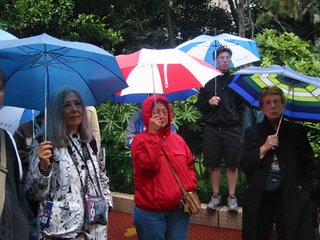
Because the Japanese didn’t really understand the Nazis hatred of the Jews, the ghetto here was different from the ones in Europe. 1. Only “Stateless” people had to live there. Which meant that the jews that had been there before could live where ever they wanted and go about their business as usual. They could send in supplies, etc. 2. Because this had been an area where Chinese also lived, they continued to live there and could get permits to enter and exit. 3. There wasn’t a wall, only checkpoints. (To me this means that it would be possible to enter or leave without permission.) The Germans had sent the “Butcher of Warsaw” to supervise a “final solution”, but the Japanese were too busy with their hereditary enemies, the Chinese, to really get into the Nazi agenda. So, although conditions were very bad, because the people were very poor and lived in crowded conditions, it was nowhere near as bad as Warsaw. (I saw pictures of the ghetto in Warsaw when I was there last summer.)
This was a building used for administration:

Chinese people are living here now. Here is a woman washing something in her home:

A street. Doors open into rooms. When the communists took over and assigned people living quarters, they assigned 1 family to each room, so 3 or 4 families would be living inside each door.
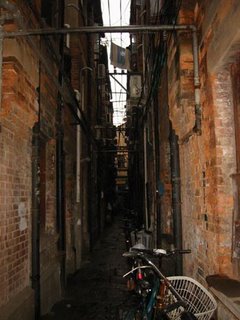
To see more about this you can go to www.shanghai-jews.com
We saw the synagogue, which houses a small museum and watched two short films about the time and the area. After the war and the communist takeover, most of the Jews left. During the Cultural Revolution all foreign influence was destroyed, so the Jewish cemeteries were eradicated and all of the headstones were taken away. Some were thrown in the river, but others were put to various uses – paving stones, washboards, etc. Dvri is trying to find them and is creating a film of his experiences.
We returned to the Bund for the end of the tour. Several of us went for lunch to a rooftop restaurant in the area. It was great to be warm and dry. We all had soup.
I went home afterwards to put my feet up and have a little rest.
They were setting up for a wedding:
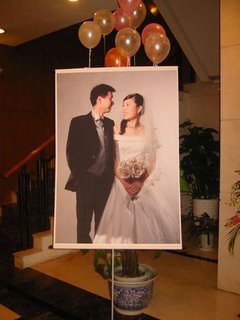

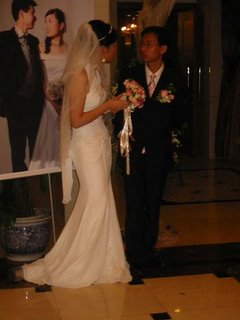
Chuck, Vahe and I went to a Sichuan restaurant. We ordered way too much food, but there were so many things we wanted to try.
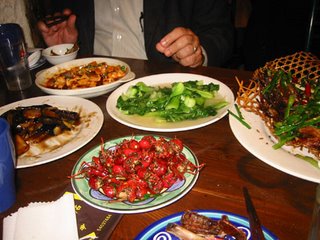
By the time we returned to the hotel, the bride was in a different dress. We learned that she might change 3 or 4 times during the evening.

The rooms are well soundproofed. We could hear the festivities in the hall, but once we were in our room it was very quiet. The other good thing is that Chinese weddings seem to end early – by about 9 or 10 o’clock.

No comments:
Post a Comment